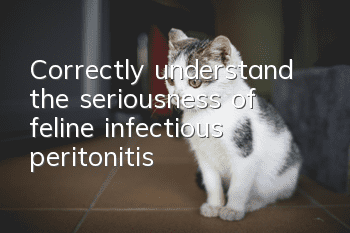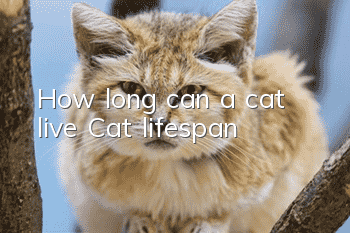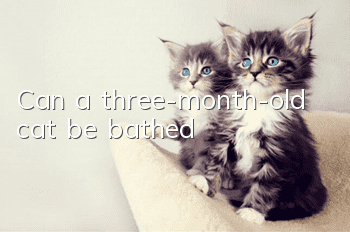Correctly understand the seriousness of feline infectious peritonitis

Regarding various diseases in cats, the most terrifying one is not feline distemper or feline leukemia virus infection, but infectious peritonitis. Compared with the survival rate of the former, the survival rate of infectious peritonitis is almost as good as that of rabies (portal:), almost 100%.
Infectious peritonitis:
Infectious peritonitis is a chronic progressive infectious disease caused by coronavirus mutations, characterized by peritonitis and the accumulation of large amounts of ascites. The virus has weak resistance to the external environment. After leaving the host, it will lose activity in one day at room temperature. Generally, it can be killed by commonly used disinfectants. The disease is mainly divided into two types: exudative (wet) and non-exudative (dry). The course of the disease lasts from 2 to 14 weeks (or longer).
1. General symptoms
· Early symptoms are not obvious/characteristic, including weight loss, loss of appetite/intermittent anorexia, physical weakness, and depression
· Jaundice
· Anemia
· Different sizes of pupils
· Upper respiratory tract symptoms
2. Exudation type (moist)
· Accumulation of ascites, distended abdomen, pain and indentation when pressed
· After 7-42 days, there is no pain in the abdomen and there is fluid
· Body temperature rises to 39.7-41.1℃
· Some cats may develop pleural effusion/pericardial effusion, causing difficulty breathing (shortness of breath), weak heartbeat, and pale mucous membranes with petechiae (or no)
· Late-stage jaundice
Note: Female cats with oozing type are often mistaken for pregnancy.
3. Non-exudative type (dry)
· Long-term fever, loss of appetite,
· Central nervous system damage (movement disorder, spasm, mild paralysis, etc.)
· Eye infection (flaming omental hemorrhage in the early stage, corneal edema/precipitates, inflammation of the iris and ciliary body, redness of the intraocular fluid/fibrin clots, etc. may later occur)
· Jaundice
· There is a mass in the abdomen
· Severe organ failure
4. Risk of infection
Infectious peritonitis can infect cats of all ages, genders, and breeds indiscriminately. Since almost 40% of the general cat population carries coronavirus, families, catteries, rescue stations, etc. that raise more than two cats increase the probability of coronavirus mutation due to the large number of cats they raise.
Among them, cats under 2 years old and over 11 years old are the main affected groups, especially purebred cats, the incidence rate is higher than that of ordinary cats. The virus is usually transmitted vertically through the digestive tract, parasites, and placenta, and cats can excrete the virus through feces and urine; it is characterized by low morbidity and high mortality.
Note: If you only keep 1-2 cats at home, the chance of contracting infectious peritonitis is only one in 5,000.
Further diagnosis from the hospital:
Due to the lack of diagnostic basis for infectious peritonitis, the diagnosis is usually confirmed through various laboratory tests.
· X-rays to determine if there is fluid accumulation in the chest and abdomen
· Test the extracted liquid
· Chemical assessment of kidney, liver and pancreatic function levels
· Heart test (to rule out heart-related problems)
· Coronavirus testing (to determine the presence of antibodies against the virus)
In addition, according to research, in exudative diseases, the fluid in the cat's abdominal cavity is colorless, transparent/light yellow, and solidifies immediately when exposed to air; the peritoneum is turbid, and is covered with fibrin-like exudate like the surfaces of the liver, spleen, and kidneys. There is still 1-3 mm of necrosis on the surface of the liver, and occasionally sick cats are accompanied by increased pleural effusion.
Treatment:
Similar to cat plague (Portal: Survive the "Seven Days of Death" and say goodbye to cat plague), there is currently no direct cure for infectious peritonitis. All that can be done is to help relieve the pain caused by the disease in cats. .
1. Antiviral drugs
· GC376, a protease inhibitor antiviral drug
· Virbagen Omega is a recombinant feline interferon omega; start treatment as soon as possible after clinical symptoms appear, subcutaneously inject INF omega every 1MU/kg, and observe for a period of time. If relief occurs, it can be changed to once a week.
Note: In drug trials, GC376 alleviated symptoms in 7 out of 20 cats; VirbagenOmega has reported cases of successful recovery in young cats.
2. Immunosuppressants
· Prednisolone is the main immunosuppressant for infectious peritonitis. It is highly safe and can also increase the cat’s appetite; take 2-4 mg/kg/day orally and reduce the dose every 10-14 days until the cat’s optimal condition is found. dosage (prednisolone can also treat lymphocytic cholangitis).
· Thalidomide (not for use in pregnant cats, purulent peritonitis/pleuritis), reduces inflammation and humoral immune response to feline coronavirus while leaving cell-mediated (antiviral) immune response intact; 50-50 at night 100mg.
Note: In the experiment with prednisolone, a cat with non-osmotic (dry) infectious peritonitis was successfully extended by 10 months; in the experiment with thalidomide, 4 cats with infectious peritonitis were Cats with peritonitis were treated, and unfortunately all died, but one cat with pleural effusion was able to eliminate the pleural effusion and extend its life by 3 months. Research shows that thalidomide needs to be administered in the early stage of the disease (too much Get treatment before your blood vessels are damaged).
3. Vitamins
· Vitamin A, 200 i.u./day, administered directly by mouth or mixed with food. Because cats cannot metabolize beta-carotene, they can be fed in the form of fish oil such as halibut liver oil. Considering that taking too much vitamin A can cause poisoning, do not consume it for more than 4-6 weeks.
· Vitamin B1, 100μg/day taken orally or mixed with food.
· Vitamin B complex, which can stimulate appetite; only use in children's dosage.
· Vitamin C, 125 mg of ascorbic acid taken orally or consumed twice a day; however, taking it for a long time will produce oxalate crystals in the urine.
·Vitamin E, 27-75 i.u./2 times a day, taken directly orally or mixed with food.
4. Others
· Aspirin, used for anti-inflammatory and analgesic; 10 mg/kg, once every 48-72 hours.
· Ampicillin, for cats taking immunosuppressants; 50mg/time.
· Anabolic steroids, which can stimulate appetite and resist catabolism (especially when the kidneys are affected)affected); there are Laurabolin injection (2-5mg/kg every 21 days), Nandrolin injection (2-5mg/kg weekly injection), Nandoral tablet (1/day), bradypeptide injection (every 21 days, 1mg/kg) and Orlando tablets (0.5mg/kg daily); taking the above drugs will increase the odor of the cat’s urine.
· Probiotics can help cats stop diarrhea
· Thromboxane synthase, 5-10 mg/kg, twice daily; prednisolone 2 mg/kg/day.
During the treatment process, remember to check the cat’s various signs regularly to observe its progress. If there is some relief, the testing time can be appropriately extended. However, the cat still felt pain during the treatment and it was recommended to euthanize it. In fact, as long as a cat suffers from infectious peritonitis, it usually only survives for a few days/weeks; if it is a non-exudative type, it may survive for a few weeks/months, and then a god-level system problem occurs. At this time, we can only end it through euthanasia. It's painful.
Note: The above management methods and research proofs come from the personal blog of Addie D.D., a British veterinary doctor who has been engaged in the veterinary industry for many years and has rich on-the-spot experience. Regarding the content related to medication, parents are asked to discuss with the doctor after a comprehensive examination before making a decision.
How to prevent cats from getting infectious peritonitis:
1. For multi-cat households and catteries
· Keep one utensil per cat and do not reuse. Especially the cat litter box, the feces should be cleaned in time every day and disinfected at least once a week.
· Age grouping. Never let kittens (under 4 months old) play with adult cats.
·Isolate cats suspected of being infected to avoid infection.
· If a lactating cat is suspected of being infected, wean the kitten (4-6 weeks) and place it alone.
2. Vaccination
Primucell FIP is a live vaccine currently developed for infectious peritonitis. It is provided in the form of an intranasal vaccine and is suitable for kittens under 16 weeks of age. However, the effect is average. It is recommended to consult a doctor before injection to determine whether the injection is needed based on the cat's condition. necessary.
If there is a cat that died of infectious peritonitis in the home/cattery, 0.2% formaldehyde or 0.5g/L ethidium chloride (chlorhexidine) can be used to disinfect the home, and the utensils used by the cat before death should be disinfected and disposed of (to prevent wild cats). contact); receivingBefore adding a new cat, observe other cats in the home for signs of illness for at least 6 months.
Recommended Good Things
Aineng Pet Odor Eliminating Disinfectant can effectively remove body odor/feces odor and other odor molecules! Effective in treating skin diseases caused by fungi/bacteria! Can kill parvovirus/canine distemper virus/coronavirusetc!
It is edible grade for pets, does not contain fragrances, does not contain chemicals, can be sprayed directly, and is harmless to human pets!
Consultation: 13028809308 (WeChat synchronization)
Scan the QR code on WeChat to enter the purchase
- How to train a Maine Coon cat to use the toilet
- How to stop cats from eating plants?
- Can cats spray toilet water on them?
- Can cats know their way home? How do cats find their way home?
- Why is the cat snoring?
- It’s OK to become addicted to petting cats. Parasites in cats are extremely harmful to humans and must be expelled on time!
- What does cat triplet mean?
- High temperature warning, how to properly cool down pets?
- Correct posture for holding a cat. Do you know the correct posture for holding a cat?
- The cat keeps meowing at night and scratches the door



